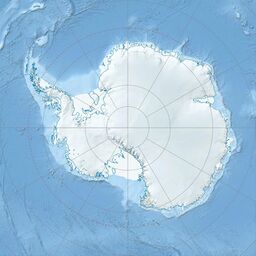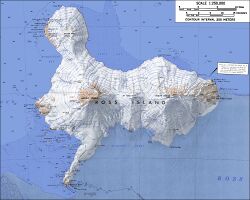Earth:Mount Bird
| Mount Bird | |
|---|---|
| Highest point | |
| Elevation | 1,765 m (5,791 ft) |
| Coordinates | [ ⚑ ] : 77°17′S 166°43′E / 77.283°S 166.717°E |
| Geography | |
| Continent | Antarctica |
| Region | Ross Dependency |
| Geology | |
| Mountain type | Shield volcano |
| Volcanic belt | McMurdo Volcanic Group |
Mount Bird ( [ ⚑ ] 77°17′S 166°43′E / 77.283°S 166.717°E) is a 1,765 metres (5,791 ft) high shield volcano standing about 7 nautical miles (13 km; 8.1 mi) south of Cape Bird, the northern extremity of Ross Island. It was mapped by the British National Antarctic Expedition, 1901–04, under Robert Falcon Scott, and apparently named by them after Cape Bird.[1]
Geography
Mount Bird was originally a separate island, which through volcanic activity has become a rounded peninsula on the northwestern tip of Ross Island. At its southernmost point, where it is connected with the rest of the island by a 10-kilometre (6.2 mi) wide isthmus, a 500-metre (1,600 ft) high pass, Bird Pass, separates the bulk of Mount Bird from the northern slopes of Mount Erebus. The peninsula is flanked to the west and east by two large and frequently ice-bound bays, Wohlschlag Bay in the west and Lewis Bay in the east.
Geology
Mount Bird is a basaltic shield volcano that was active from 4.6 to 3.8 million years ago. On the flanks of the volcano there are poorly exposed basalt scoria cones, and phonolite domes and flows. The coastal cliffs display the shield's thick stack of basalt lava flows.[2]
Inland features
Endeavour Piedmont Glacier and Shell Glacier lie on or below the slopes of Mount Bird.[3][4] Other inland features around Mount Bird include Cinder Hill, Trachyte Hill, Inclusion Hill.[5]
Cinder Hill
[ ⚑ ] 77°17′S 166°26′E / 77.283°S 166.433°E. A prominent dissected volcano, 305 metres (1,001 ft) high, consisting of layers of red basalt scoria and cinders and abundant olivine nodules, standing between Harrison Stream and Wilson Stream on the ice-free lower west slopes of Mount Bird. Mapped and descriptively named by the New Zealand Geological Survey Antarctic Expedition (NZGSAE), 1958-59.[6]
Quaternary Icefall
[ ⚑ ] 77°18′S 166°30′E / 77.3°S 166.5°E. A western lobe of the Mount Bird icecap, descending steeply into Wohlschlag Bay 1 nautical mile (1.9 km; 1.2 mi) south of Cinder Hill. Mapped and so named by the NZGSAE, 1958-59, because of the Quaternary glacial period marine shells carried by the glacier and deposited in terminal moraines.[7]
Harrison Stream
[ ⚑ ] 77°17′S 166°24′E / 77.283°S 166.4°E. A small stream flowing west between Trachyte and Cinder Hills to the north end of Romanes Beach. Mapped by the NZGSAE, 1958-59. Named by the New Zealand Antarctic Place-Names Committee (NZ-APC) for J. Harrison, mountaineer-assistant with the expedition.[8]
Alexander Hill
[ ⚑ ] 77°17′S 166°25′E / 77.283°S 166.417°E. A hill, 220 metres (720 ft) high, with a prominent seaward cliff face, lying south of Harrison Stream and Cinder Hill on the lower ice-free west slopes of Mount Bird. Mapped by the NZGSAE, 1958-59, and named by the NZ-APC for B.N. Alexander, a surveyor with the expedition.[9]
Wilson Stream
[ ⚑ ] 77°17′S 166°26′E / 77.283°S 166.433°E. A meltwater stream which flows from the ice-free lower west slopes of Mount Bird, to the south of Alexander Hill, and over steep sea cliffs into Wohlschlag Bay. Mapped by the NZGSAE, 1958-59, and named by the NZ-APC for J. Wilson, mountaineer assistant with the expedition.[10]
Trachyte Hill
[ ⚑ ] 77°17′S 166°25′E / 77.283°S 166.417°E. A prominent hill, 470 metres (1,540 ft) high, just south of Shell Glacier in the center of the ice-free area on the lower west slopes of Mount Bird. Mapped and so named by the NZGSAE, 1958-59, because of the rock type composing the hill.[11]
Fitzgerald Hill
[ ⚑ ] 77°16′S 166°25′E / 77.267°S 166.417°E. A hill, 230 metres (750 ft) high, standing west of Mount Bird between Fitzgerald Stream and Shell Glacier. Mapped by the NZGSAE, 1958-59, and named by the NZ-APC for E.B. Fitzgerald, deputy leader of the expedition.[12]
Fitzgerald Stream
[ ⚑ ] 77°16′S 166°21′E / 77.267°S 166.35°E. A stream between Fitzgerald Hill and Inclusion Hill on the lower ice-free west slopes of Mount Bird, flowing to McMurdo Sound across McDonald Beach. Explored by the NZGSAE, 1958-59, and named by the NZ-APC for E.B. Fitzgerald, deputy leader of the expedition.[12]
Inclusion Hill
[ ⚑ ] 77°15′S 166°25′E / 77.25°S 166.417°E. A prominent steeply concial hill, 335 metres (1,099 ft) high, between McDonald Beach and the Mount Bird icecap. It is a trachyte plug, in parts containing numerous inclusions of basalt. Explored and descriptively named by the NZGSAE, 1958-59.[13]
Coastal features
Coastal features around Mount Bird include Romanes Beach, McDonald Beach, Caughley Beach, Cape Bird Hut and Cape Bird.[5]
Romanes Beach
[ ⚑ ] 77°17′S 166°22′E / 77.283°S 166.367°E. Beach on the north shore of Wohlschlag Bay just south of Harrison Bluff. Mapped by a party of the NZGSAE, 1958-59, landed there by the USS Arneb. Named by the NZ-APC for W. Romanes, mountaineer assistant with the expedition.[14]
McDonald Beach
[ ⚑ ] 77°15′S 166°21′E / 77.25°S 166.35°E. An extensive beach lying west of Inclusion Hill and 6 nautical miles (11 km; 6.9 mi) southwest of Cape Bird. Named by the NZGSAE, 1958-59, after Captain Edwin A. McDonald, then Deputy Commander, United States Naval Support Force, Antarctica, who provided extensive transport and other facilities to the NZGSAE in support of the survey of the Cape Bird area.[15]
Harrison Bluff
[ ⚑ ] 77°17′S 166°23′E / 77.283°S 166.383°E. A pale-colored trachyte headland forming the seaward termination of Trachyte Hill and marking the southern end of McDonald Beach on the western side of Mount Bird. Many skuas nest on the bluff. A survey station marked by a rock cairn was placed on the top of the northwest corner of the bluff by E.B. Fitzgerald of the Cape Bird Party of the NZGSAE, 1958-59. Named by the NZ-APC for J. Harrison, mountaineer-assistant with the expedition.[16]
Waipuke Beach
[ ⚑ ] 77°14′S 166°24′E / 77.233°S 166.4°E. Beach between McDonald and Caughley Beaches, lying 6 nautical miles (11 km; 6.9 mi) southwest of Cape Bird. So named by the NZGSAE, 1958-59, because of periodic flooding by meltwater from the Cape Bird icecap, which has been destructive to nearby penguin rookeries. Waipuke is the Maori word for flood.[17]
Caughley Beach
[ ⚑ ] 77°14′S 166°25′E / 77.233°S 166.417°E. The northernmost beach on the ice-free coast southwest of Cape Bird. Mapped by the NZGSAE, 1958-59, and named for Graeme Caughley, biologist with the party that visited Cape Bird.[18]
Cape Bird
[ ⚑ ] 77°10′S 166°41′E / 77.167°S 166.683°E. Cape which marks the north extremity of Ross Island. Discovered in 1841 by a British expedition under Ross, and named by him for Lieutenant Edward J. Bird of the ship Erebus.[1]
Beaufort Island
[ ⚑ ] 76°56′S 166°56′E / 76.933°S 166.933°E. An island in the Ross Sea, the northernmost feature of the Ross Archipelago, lying 12 nautical miles (22 km; 14 mi) north of Cape Bird. Discovered and named in 1841 by Ross for Captain Francis Beaufort, Royal Navy, Hydrographer to the Admiralty.[19]
References
- ↑ 1.0 1.1 Alberts 1995, p. 67.
- ↑ Wright & Kyle 1990, pp. 97–98.
- ↑ Endeavour Piedmont Glacier USGS.
- ↑ Alberts 1995, p. 669.
- ↑ 5.0 5.1 Ross Island USGS.
- ↑ Alberts 1995, p. 136.
- ↑ Alberts 1995, pp. 598–599.
- ↑ Alberts 1995, p. 315.
- ↑ Alberts 1995, p. 11.
- ↑ Alberts 1995, p. 818.
- ↑ Alberts 1995, p. 755.
- ↑ 12.0 12.1 Alberts 1995, p. 242.
- ↑ Alberts 1995, p. 359.
- ↑ Alberts 1995, p. 627.
- ↑ Alberts 1995, p. 475.
- ↑ Alberts 1995, p. 314.
- ↑ Alberts 1995, p. 790.
- ↑ Alberts 1995, p. 124.
- ↑ Alberts 1995, p. 53.
Sources
- Alberts, Fred G., ed. (1995), Geographic Names of the Antarctic (2 ed.), United States Board on Geographic Names, https://pubs.usgs.gov/fedgov/70039167/report.pdf, retrieved 2024-01-30
 This article incorporates public domain material from websites or documents of the United States Board on Geographic Names.
This article incorporates public domain material from websites or documents of the United States Board on Geographic Names. - Template:Cite gnis2
- Ross Island, USGS: United States Geological Survey, https://commons.wikimedia.org/wiki/File:RossIslandMap.jpg, retrieved 2024-01-30
- Wright, A.C.; Kyle, P.R. (1990), "A.15. Mount Bird", in LeMasurier, W.E.; Thomson, J.W., Volcanoes of the Antarctica Plate and Southern Oceans, Antarctica Research, 48, American Geophysical Union, https://web.archive.org/web/20131029194449/http://volcano.oregonstate.edu/vwdocs/volc_images/antarctica/bird.html
 |



